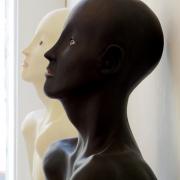
The Union Gallery this month features the first ever joint showing in Edinburgh of work by husband and wife Jim McCutcheon and Linda Downie.
Really is an exhibition of strong contrasts and subtle similarities, of memorable images which often raise as many questions as they answer. If there is one thing of which one can be certain here, it is that reality, in Really, defies definition, and can certainly not be relied upon.
Perhaps the most obvious starting point is McCutcheon’s ‘I didn’t do it’ and ‘It wasn’t me’: identical figures of naked boys leaning awkwardly, uncomfortably, against the wall, their gaze cast up, hands tucked behind, elongated chests and genitals exposed and vulnerable.
They are distinguished only by the colour of their ‘skins’ and ‘irises’.
The titles of the twin works – presumably responses to the same unspoken accusation – are similarly framed and equally plausible denials. Each implies the guilt of the other.
So how are we to decide between these matching rebuttals? From what tones and expressions should we infer innocence?
Or is it we, the merciless and uninterrupted viewers, louring or leering down at the boys, who have most to apologise for?
Here, the metallic regularity and tonal spacing of the bells is subverted by the impossible way in which they hang. Their complicated weightlessness is matched by the upward tip-toe tension of a curvaceous, plumptiously bottomed female form.
So far so good, only that erotic potential is itself cut short by the absence of a head, the shocking truncation of the neck and body into a gaping red tube. There is no evidence of violence, no hideous bonce rolling across the floor. Instead we are left in a silence to consider these problematic contrasts as normal, to lean backwards, stressed and uncomfortable against Downie’s unpredictable certainties.
Downie’s images of female bodies here are often torn, unzipped, decapitated, or – as in ‘Prey’ (below), with organs removed and displayed on a stag’s antlers like trophies. Are we to read this as a female torn apart by a male, or are both woman and stag the victims here? Once again in Really, there are awkward questions but no clear solutions.
McCutcheon’s ‘Fiddler/Angel of Chaos’ (below) is another combination of confounded physical expectations.
The benign, not quite human head’s smile belies the muddled limbs: the leg as violin, the straw and wood as legs, the crow wings, the claw hand, the green torso.
Despite their similarity to some nightmare vision of Hieronymus Bosch, the effect in this instance is not so much threatening as creative, as if McCutcheon imagines, condones and gives three dimensions to a force subverting normal boundaries and unleashing new possibilities.
It is the same interplay of constraint and release which Downie explores in paintings such as ‘Glass Jacket’, ‘Beast’ and their combination in ‘The Maid and Monkey’ (below). In the latter, an ungovernable wildness and intelligence patrols within the temporary social bounds of a dress. One feels sure it must eventually escape.
In other paintings here, women also transcend victimhood as sexually knowing half-vixen, as destruction-dealing dancing tornado, as the unsettling bard of storms and bears.
Both Downie and McCutcheon revel in mysteries, in unquantifiable archetypes like ‘Sun Deity’, which hides Death in its interior, or the playfully titled ‘Trimaster’ (below), a threesome of three-months, realised – I think – as pregnant men.
For this reviewer, the climax of the exhibition was Downie’s unforgettable ‘Bounty of the Implausible Vine’ (below).
The implausible stump bears grapes, cherries and a peach, and grows out of the headless, armless body of a naked woman astride a fabulous, braided muleopard. The image seems to emerge – baffling and fantastic – from some ancient Creation myth. It invites one to revel in its simultaneous sensuality and oddity. It is the antithesis of scientific knowledge, an invocation of strangeness, an act of defiance, and an invitation to that alternative reality which sometimes makes a kind of fluid sense in dreams.
Thinking back, there were large parts of this exhibition which I both didn't understand and didn’t want to. Sometimes, not knowing can be the most enlightening experience of all. AM
Linda Downie and Jim McCutcheon’s Really continues at the Union Gallery (45 Broughton Street) until 1 July.